Japan Book Review: Black Ships Illustrated Japanese History - The Americans Arrive
Black Ships Illustrated Japanese History - The Americans Arrive
ISBN: 978-1-62317-091-2
North Atlantic Books, 2017
105pp; paperback
 |
| Black Ships Illustrated Japanese History - The Americans Arrive |
Most people even vaguely familiar with Japanese history will recognize the name of Commodore Matthew Perry, the American who is usually credited with the opening of Japan to Western trading.
Those a little more familiar with Japanese history will know that there was trading going on before Perry and his four Black Ships showed up unannounced on May 17, 1853; specifically trading between the Dutch and the Japanese (limited to Dejima, an artificial island off of Nagasaki) and some trading with the Chinese.
Sean Michael Wilson has written this graphic novel filling in Japanophiles on more details about Perry and his trips (there were two) to Japan.
On Perry's first trip he came with a letter from U.S. President Millard Fillmore demanding that the U.S. be allowed to trade with Japan. The Japanese were not amused.
Perry was a gruff, tough-minded man who would not take no for an answer. He demanded that he deliver Fillmore's letter in person to Japan's highest-ranking officials in person. The Japanese bakufu (leaders) were trying to get Perry to go to Dejima and trying to let a lesser person receive the letter. Perry said "no" and gave the Japanese a threat along the lines of "we'll be back and we'd better get what we want.
Perry and his four ships, called the Plymouth, Mississippi, Saratoga and Susquehanna, then sailed back to America, signing an agreement with the Ryukyu Kingdom (now Okinawa) on the way back. Perry returned earlier than originally planned, this time with 10 ships and more artillery. The early return was mostly because America garnered information that other countries such as Russia and England were closing in on Japan and trying to set up their own trade agreements.
Russia brought ships to Japan just after Perry left, but the ships were destroyed in the aftermath of an earthquake, leaving the Russians stranded. Still, they managed to score some trading agreements as Japan figured if they could trade with America they might as well trade with Russia.
Even readers who think they know a lot about Japan's opening to the West will likely glean new information into a fascinating and important part of Japanese and American history.
One slightly annoying part of the book is that there are at several places where multiple random question marks are inserted in the dialogues. Besides that, the book is interesting, informative and well-drawn, but at only 105 pages it is not exactly a graduate-class level on Perry and his impact on Japan's history. Of course, not many graphic novels are graduate-class level tomes. Black Ships can easily be read in one sitting.
Note: The book is the first of, to date, two graphic novels by Sean Michael Wilson about Japan. The second in the series is focused on the Satsuma Rebellion.
Review by Marshall Hughes.
Buy this book from Amazon USA | UK | Japan
Looking to buy Japanese things directly from Japan? GoodsFromJapan is here to help.
More Japan Book Reviews
All About Japan - Stories, Songs, Crafts and Games for Kids
Exposure: From President to Whistleblower at Olympus
Japanese Kokeshi Dolls: The Woodcraft and Culture of Japan's Iconic Wooden Dolls

No comments:
Post a Comment